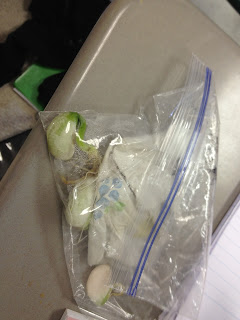After we decide what a plant needs to survive, we plant lima beans. Do this a few days before your seed lesson so that kiddos can start to see what happens to the seed.
1. Give each student a small zipped locked baggie, 2 lima bean seeds (at local grocery store), and a wet (but not dripping) folded paper towel.
2. Kiddos place the seeds against the wet paper towel and then zip up the baggie.
3. After they put their name on the bag, we tape them to the window with the seeds facing us so we can see each stage of growth.
4. As a class, we predict what part of the plant will come out first. We also record our observations in our science journals.
This is a great project to refer back to throughout the unit. After the seeds start to grow leaves, we transport them into clear plastic cups with soil. Kids always want to know how the seed grows if it is not in soil. The seed doesn't need the soil until the leaves start to grow because it gets all of its food from the food source surrounding the embryo. Once that food source is gone, the roots have to start bringing in water and minerals from the soil. The baggie is also a good way to refer to the water cycle and how plants "breathe" in oxygen (from the evaporating water) and "breathe" out carbon dioxide.
When I introduce roots to my kiddos, I first take them outside with our science journals and we go rip up plants from our playground field. Don't worry, I talk to them about only pulling weeds, grass, and wildflowers, not anything that may have been planted for our school.
We then form a circle outside and each kiddo shares what he/she found. We discussed why we think the plants have roots. Lots of them notice it was kind of hard to pull the plant out with the roots attached. This leads into a discussion about how plants use the roots to stay in the ground so they don't get blown away.
We also draw a quick sketch of our roots so we can refer back to them later. You may want to have parents donate (or you donate) some roots from the store. (carrots, rhubarbs, potatoes, radish, etc.)
Want some more resources and ideas? Check out this detailed unit! The pics below don't even cover all the resources provided!
What are some fun things you do with plants?








We would surely have a better results with regards to same probabilities as mentioned here, also there will be such more evident thoughts that one needed to be followed. usc pharmacy supplemental application
ReplyDeleteاهم شركات نقل العفش بالطائف
ReplyDeleteنقل العفش بالرياض
شركات نقل العفش بنجران
شركات نقل العفش بخميس مشيط
شركة نقل عفش بحائل